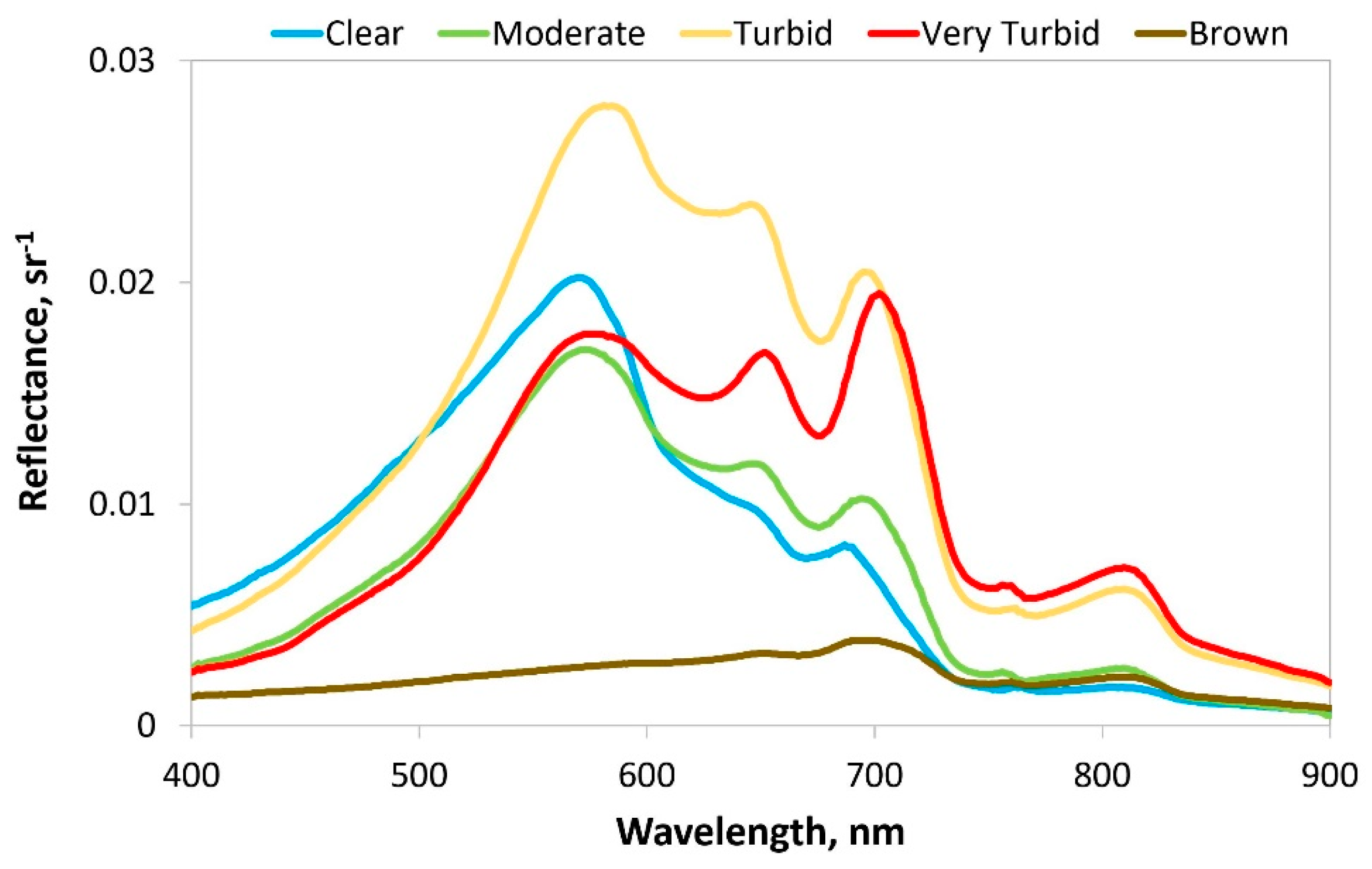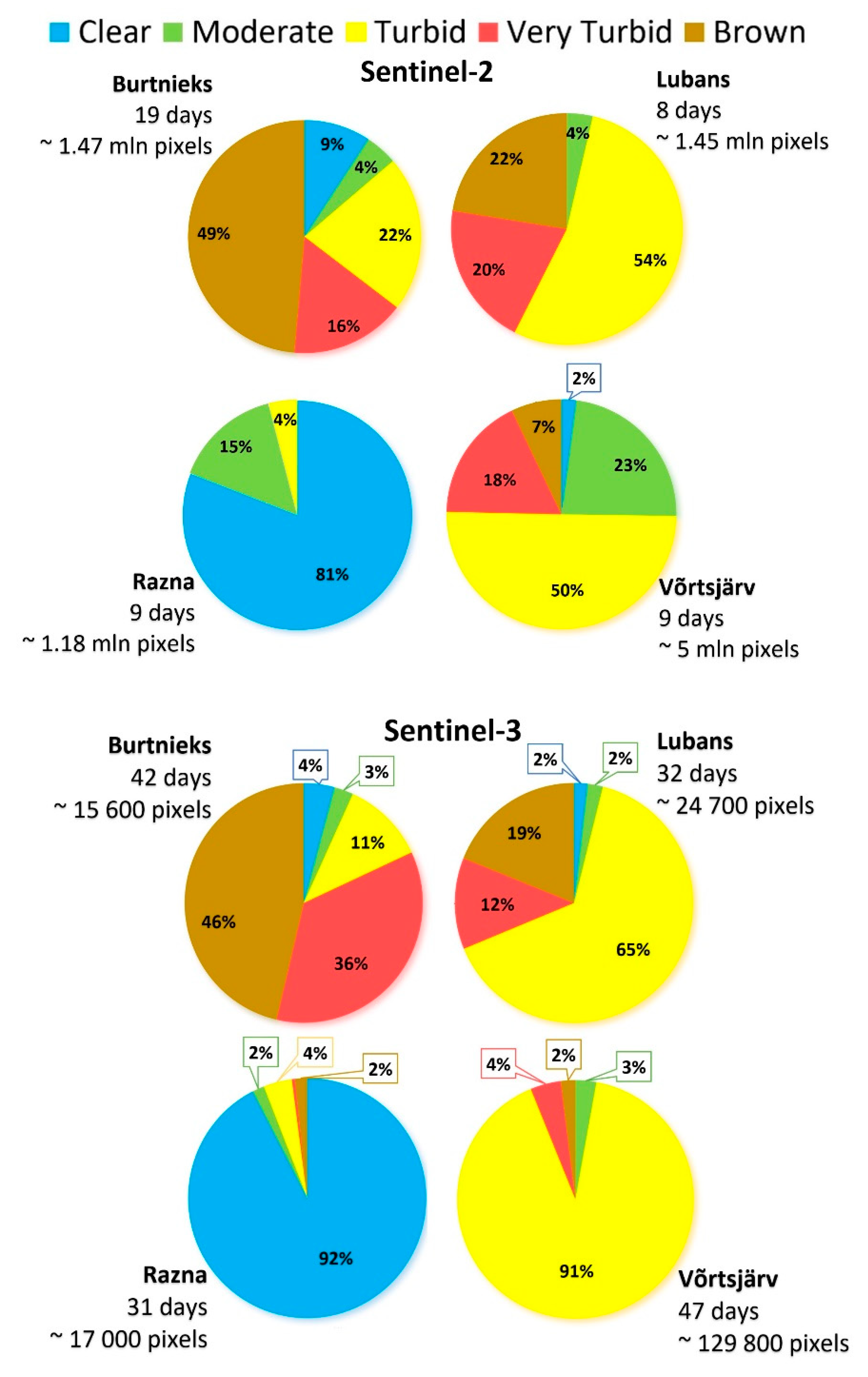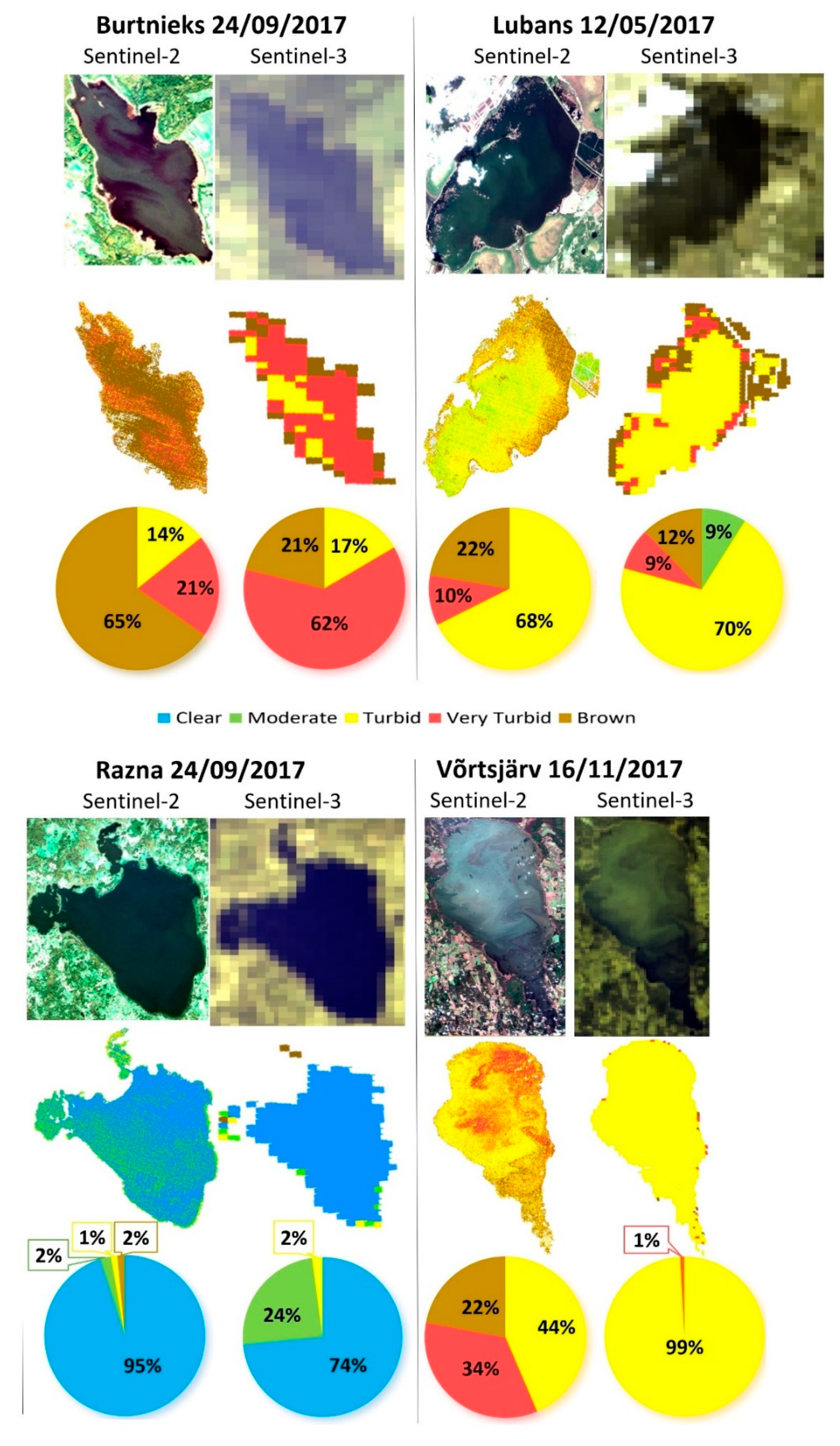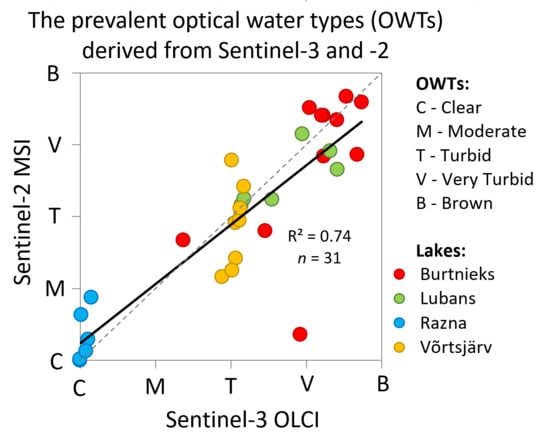Comparison of Lake Optical Water Types Derived from Sentinel-2 and Sentinel-3
Abstract
1. Introduction
2. Materials and Methods
2.1. Study Sites
2.1.1. Lake Burtnieks
2.1.2. Lake Lubans
2.1.3. Lake Razna
2.1.4. Lake Võrtsjärv
2.2. Satellite Data
2.3. Classification of Optical Water Type (OWT)
3. Results and Discussion
3.1. Comparison of the OWT Variability
3.2. Spatial Variability
3.3. Temporal Variability
4. Conclusions
Author Contributions
Funding
Conflicts of Interest
References
- The European Parliament; The Council of the European Union. WFD Directive 2000/60/EC of the European Parliament and of the Council of 23 October 2000 establishing a framework for Community action in the field of water policy. Off. J. Eur. Parliam. 2000, 372, 275–346. [Google Scholar]
- Bukata, R.P. Retrospection and introspection on remote sensing of inland water quality: Like déjà vu all over again. J. Great Lakes Res. 2013, 39, 2–5. [Google Scholar] [CrossRef]
- Palmer, S.C.J.; Kutser, T.; Hunter, P.D. Remote sensing of inland waters: Challenges, progress and future directions. Remote Sens. Environ. 2015, 157, 1–8. [Google Scholar] [CrossRef]
- Matthews, M.W.; Bernard, S.; Lain, L.R.; Griffith, D.; Odermatt, D.; Kutser, T. Understanding the Satellite Signal from Inland and Coastal Waters. In Earth Observations in Support of Global Water Quality Monitoring; IOCCG Report Series, No. 17; Greb, S., Dekker, A., Binding, C., Eds.; International Ocean Color Coordinating Group: Dartmouth, NS, Canada, 2018; pp. 55–68. [Google Scholar]
- Morel, A.; Prieur, L. Analysis of variations in ocean color. Limnol. Oceanogr. 1977, 22, 709–722. [Google Scholar] [CrossRef]
- Baker, K.S.; Smith, R.C. Bio-optical classification and model of natural waters. Limnol. Oceanogr. 1982, 27, 500–509. [Google Scholar] [CrossRef]
- Moore, T.S.; Campbell, J.W.; Dowell, M.D. A class-based approach to characterizing and mapping the uncertainty of the MODIS ocean chlorophyll product. Remote Sens. Environ. 2009, 113, 2424–2430. [Google Scholar] [CrossRef]
- Moore, T.S.; Dowell, M.D.; Bradt, S.; Ruiz-Verdú, A. An optical water type framework for selecting and blending retrievals from bio-optical algorithms in lakes and coastal waters. Remote Sens. Environ. 2014, 143, 97–111. [Google Scholar] [CrossRef]
- Melin, F.; Vantrepotte, V. How optically diverse is the coastal ocean? Remote Sens. Environ. 2015, 160, 235–251. [Google Scholar] [CrossRef]
- Reinart, A.; Herlevi, A.; Arst, H.; Sipelgas, L. Preliminary optical classification of lakes and coastal waters in Estonia and South-Finland. J. Sea Res. 2003, 49, 357–366. [Google Scholar] [CrossRef]
- Le, C.; Li, Y.; Zha, Y.; Sun, D.; Huang, C.; Zhang, H. Remote estimation of chlorophyll a in optically complex waters based on optical classification. Remote Sens. Environ. 2011, 115, 725–737. [Google Scholar] [CrossRef]
- Shi, K.; Li, Y.; Zhang, Y.; Li, L.; Lv, H.; Song, K. Classification of inland waters based on bio-optical properties. J. Sel. Top. Appl. Earth Observ. Remote Sens. 2014, 7, 543–561. [Google Scholar] [CrossRef]
- Shen, Q.; Li, J.; Zhang, F.; Sun, X.; Li, J.; Li, W.; Zhang, B. Classification of several optically complex waters in China using in situ remote sensing reflectance. Remote Sens. 2015, 7, 429–440. [Google Scholar] [CrossRef]
- Eleveld, M.A.; Ana, B.; Ruescas, A.B.; Hommersom, A.; Moore, T.S.; Peters, S.W.M.; Brockmann, C. An Optical Classification Tool for Global Lake Waters. Remote Sens. 2017, 9, 420. [Google Scholar] [CrossRef]
- Spyrakos, E.; O’Donnell, R.; Hunter, P.; Miller, C.; Scott, M.; Simis, S.; Neil, C.; Barbosa, C.; Binding, C.; Bradt, S.; et al. Optical types of inland and coastal waters. Limnol. Oceanogr. 2018, 63, 846–870. [Google Scholar] [CrossRef]
- Uudeberg, K.; Ansko, I.; Põru, G.; Ansper, A.; Reinart, A. Using Optical Water Types to Monitor Changes in Optically Complex Inland and Coastal Waters. Remote Sens. 2019, 11, 2297. [Google Scholar] [CrossRef]
- Wetzel, R.G. Limnology. Lake and River Ecosystems, 3rd ed.; Academic Press: Cambridge, MA, USA, 2001. [Google Scholar]
- Ogashawara, I.; Mishra, D.R.; Gitelson, A.A. Remote Sensing of Inland Waters: Background and Current State-of-the-Art. In Bio-Optical Modeling and Remote Sensing of Inland Waters; Mishra, D.R., Ogashawara, I., Gitelson, A.A., Eds.; Elsevier Inc.: Amsterdam, The Netherlands, 2017; pp. 1–24. [Google Scholar]
- Dörnhöfer, K.; Oppelt, N. Remote sensing for lake research and monitoring-recent advances. Ecol. Indic. 2016, 64, 105–122. [Google Scholar] [CrossRef]
- Copernicus. Available online: http://www.copernicus.eu (accessed on 11 October 2019).
- Toming, K.; Kutser, T.; Laas, A.; Sepp, M.; Paavel, B.; Nõges, T. First Experiences in Mapping Lake Water Quality Parameters with Sentinel-2 MSI Imagery. Remote Sens. 2016, 8, 640. [Google Scholar] [CrossRef]
- Ansper, A.; Alikas, K. Retrieval of Chlorophyll a from Sentinel-2 MSI Data for the European Union Water Framework Directive Reporting Purposes. Remote Sens. 2019, 11, 64. [Google Scholar] [CrossRef]
- Molkov, A.A.; Fedorov, S.V.; Pelevin, V.V.; Korchemkina, E.N. Regional Models for High-Resolution Retrieval of Chlorophyll a and TSM Concentrations in the Gorky Reservoir by Sentinel-2 Imagery. Remote Sens. 2019, 11, 1215. [Google Scholar] [CrossRef]
- Zeng, C.; Binding, C. The Effect of Mineral Sediments on Satellite Chlorophyll-a Retrievals from Line-Height Algorithms Using Red and Near-Infrared Bands. Remote Sens. 2019, 11, 2306. [Google Scholar] [CrossRef]
- GLaSS Deliverable D5.5: Boreal Lakes Case Study Results. Available online: http://www.glass-project.eu/assets/Deliverables/GLaSS-D5.5-Final.pdf (accessed on 1 August 2019).
- ESA Earth Online. Available online: earth.esa.int/web/guest/missions/esa-eo-missions (accessed on 8 October 2019).
- Ezeri.lv. Available online: http://www.ezeri.lv (accessed on 5 February 2019).
- LEGMC (State Limited Liability Company “Latvian Environment, Geology and Meteorology Centre”) National Monitoring Database. Available online: http://www.meteo.lv/lapas/noverojumi/virszemes-udens/virszemes-udens_ievads?id=1369&nid=477 (accessed on 8 March 2018).
- Mäemets, A. Eesti NSV Järved ja Nende Kaitse; Valgus: Tallinn, Estonia, 1977. [Google Scholar]
- Reinart, A.; Nõges, P. Light conditions in Lake Võrtsjärv. In Lake Võrtsjärv; Haberman, J., Pihu, E., Raukas, A., Eds.; Estonian Encyclopedia Publishers: Tallinn, Estonia, 2004; pp. 141–149. [Google Scholar]
- Paavel, B.; Arst, H.; Reinart, A. Variability of bio-optical parameters in two North-European large lakes. Hydrobiologia 2008, 599, 201–211. [Google Scholar] [CrossRef]
- Nõges, T.; Nõges, P.; Laugaste, R. Water level as the mediator between climate change and phytoplankton composition in a large shallow temperate lake. Hydrobiologia 2003, 506, 257–263. [Google Scholar] [CrossRef]
- Copernicus Open Access Hub. Available online: scihub.copernicus.eu (accessed on 17 February 2018).
- Copernicus Online Data Access. Available online: coda.eumetsat.int (accessed on 17 February 2018).
- Zuhlke, M.; Fomferra, N.; Brockmann, C.; Peters, M.; Veci, L.; Malik, J.; Regner, P. SNAP (sentinel application platform) and the ESA sentinel 3 toolbox. In Proceedings of the Sentinel-3 for Science Workshop, Venice, Italy, 2–5 June 2015; Volume 734. [Google Scholar]
- Brockmann, C.; Doerffer, R.; Peters, M.; Kerstin, S.; Embacher, S.; Ruescas, A. Evolution of the C2RCC neural network for Sentinel 2 and 3 for the retrieval of ocean colour products in normal and extreme optically complex waters. In Proceedings of the Living Planet Symposium, Prague, Czech Republic, 9–13 May 2016; Volume 740, p. 54. [Google Scholar]
- Homayouni, S.; Roux, M. Hyperspectral image analysis for material mapping using spectral matching. Int. Arch. Photogramm. Remote Sens. Spat. Inf. Sci. 2004, 35, 49–54. [Google Scholar]
- Bilaletdin, Ä.; Frisk, T.; Kaipainen, H. An integrated modelling system for the water protection project of Lake Burtnieks. Int. Ver. Theor. Angew. Limnol. Verhandl. 2006, 29, 1399–1403. [Google Scholar] [CrossRef]
- Nõges, P.; Tuvikene, L. Spatial and annual variability of environmental and phytoplankton indicators in Lake Võrtsjärv: Implications for water quality monitoring. Estonian J. Ecol. 2012, 61, 227–246. [Google Scholar] [CrossRef]
- Raukas, A. Bottom deposits. In Lake Võrtsjärv; Haberman, J., Pihu, E., Raukas, A., Eds.; Estonian Encyclopedia Publishers: Tallinn, Estonia, 2004; pp. 79–86. [Google Scholar]
- LEGMC (State Limited Liability Company “Latvian Environment, Geology and Meteorology Centre”), Assessment on Data Availability and Quality. Available online: www.meteo.lv/fs/CKFinderJava/userfiles/files/Par_centru/ES_projekti/Projekts_Udens_kvalitate/Assessment_on_data_availability_and_quality.doc (accessed on 9 October 2019).
- Keskkonnaministeerium (Ministry of the Environment), Water Monitoring Program 2016–2021. Available online: http://www.envir.ee/et/eesmargid-tegevused/vesi/vesikondade-veeseireprogramm-2016-2021 (accessed on 14 October 2019).






| Month | Mar | Apr | May | Jun | Jul | Aug | Sep | Oct | Nov |
|---|---|---|---|---|---|---|---|---|---|
| T in °C | 4 | 7.5 | 15 | 17.5 | 20 | 20 | 15 | 7.5 | 4 |
| Lake | Burtnieks | Lubans | Razna | Võrtsjärv | ||||
|---|---|---|---|---|---|---|---|---|
| Satellite | S2 | S3 | S2 | S3 | S2 | S3 | S2 | S3 |
| No. of scenes | 19 | 42 | 8 | 32 | 9 | 31 | 9 | 47 |
| No. of pixels | 1,478,576 | 17,521 | 1,463,540 | 33,519 | 1,179,890 | 18,701 | 4,972,075 | 132,849 |
| Clear % | 8.1 | 3.7 | 0 | 1.3 | 80.1 | 83.7 | 2.0 | 0.1 |
| Moderate % | 4.1 | 2.3 | 3.4 | 1.5 | 15.0 | 1.5 | 22.9 | 2.8 |
| Turbid % | 19.6 | 10.0 | 50.8 | 46.7 | 4.0 | 3.5 | 49.5 | 88.5 |
| Very Turbid % | 14.5 | 31.5 | 19.0 | 8.9 | 0.3 | 0.4 | 17.3 | 4.1 |
| Brown % | 44.0 | 41.0 | 21.2 | 13.6 | 0.4 | 1.5 | 7.0 | 1.9 |
| Unclassified % | 9.6 | 11.5 | 5.6 | 28.0 | 0.3 | 9.4 | 1.3 | 2.7 |
© 2019 by the authors. Licensee MDPI, Basel, Switzerland. This article is an open access article distributed under the terms and conditions of the Creative Commons Attribution (CC BY) license (http://creativecommons.org/licenses/by/4.0/).
Share and Cite
Soomets, T.; Uudeberg, K.; Jakovels, D.; Zagars, M.; Reinart, A.; Brauns, A.; Kutser, T. Comparison of Lake Optical Water Types Derived from Sentinel-2 and Sentinel-3. Remote Sens. 2019, 11, 2883. https://doi.org/10.3390/rs11232883
Soomets T, Uudeberg K, Jakovels D, Zagars M, Reinart A, Brauns A, Kutser T. Comparison of Lake Optical Water Types Derived from Sentinel-2 and Sentinel-3. Remote Sensing. 2019; 11(23):2883. https://doi.org/10.3390/rs11232883
Chicago/Turabian StyleSoomets, Tuuli, Kristi Uudeberg, Dainis Jakovels, Matiss Zagars, Anu Reinart, Agris Brauns, and Tiit Kutser. 2019. "Comparison of Lake Optical Water Types Derived from Sentinel-2 and Sentinel-3" Remote Sensing 11, no. 23: 2883. https://doi.org/10.3390/rs11232883
APA StyleSoomets, T., Uudeberg, K., Jakovels, D., Zagars, M., Reinart, A., Brauns, A., & Kutser, T. (2019). Comparison of Lake Optical Water Types Derived from Sentinel-2 and Sentinel-3. Remote Sensing, 11(23), 2883. https://doi.org/10.3390/rs11232883






